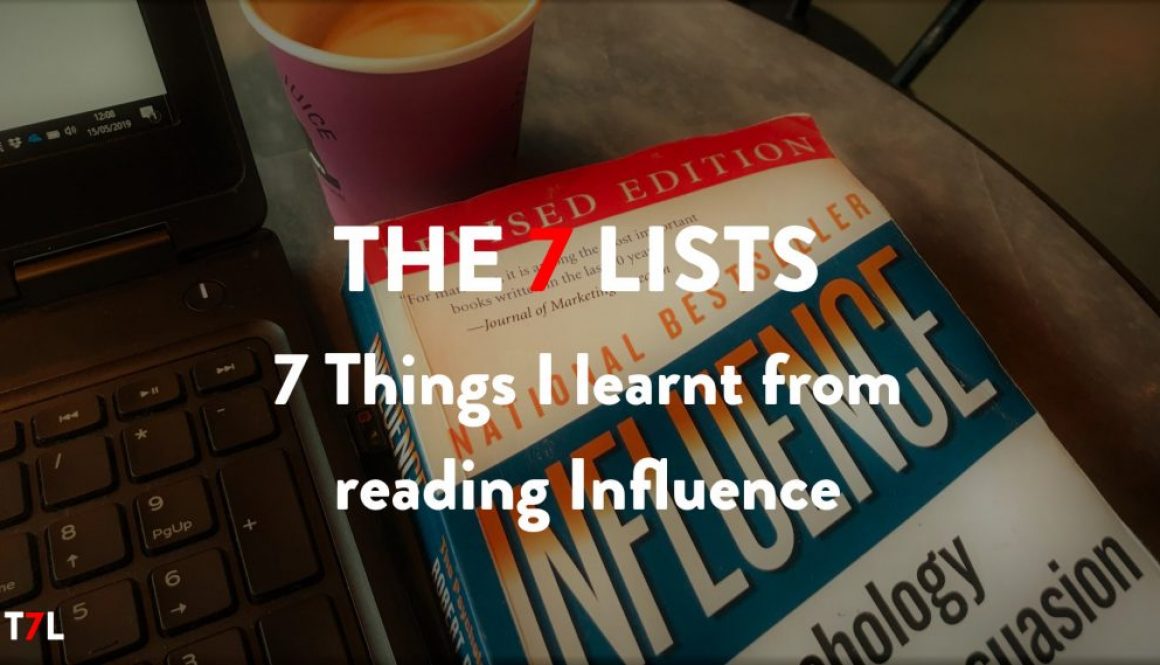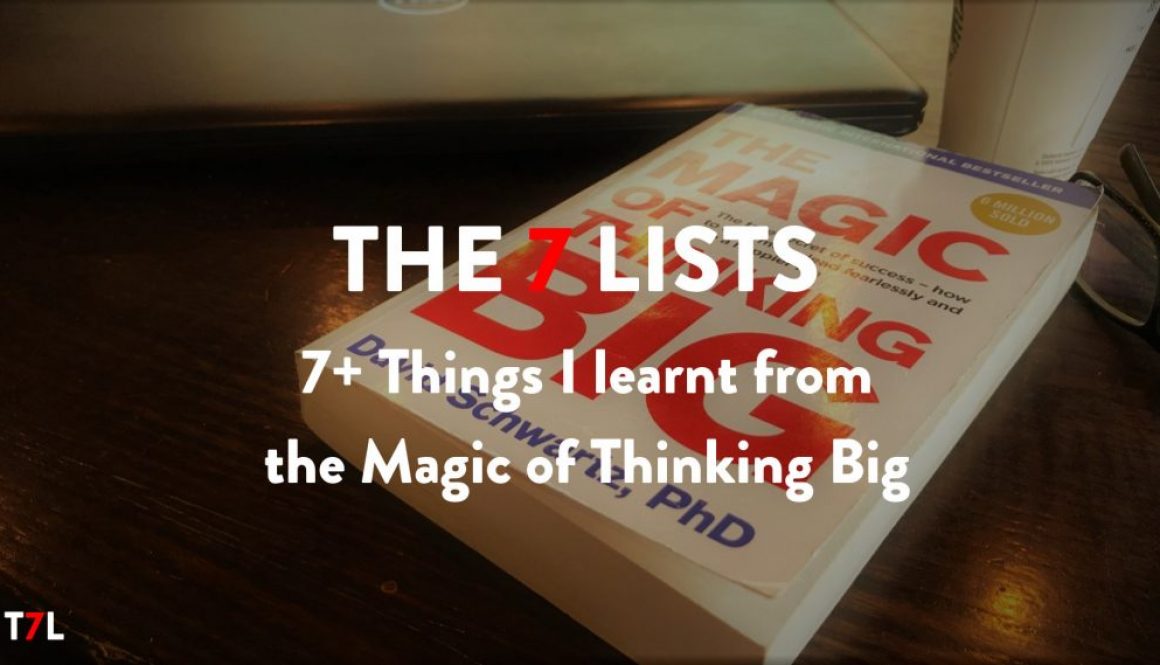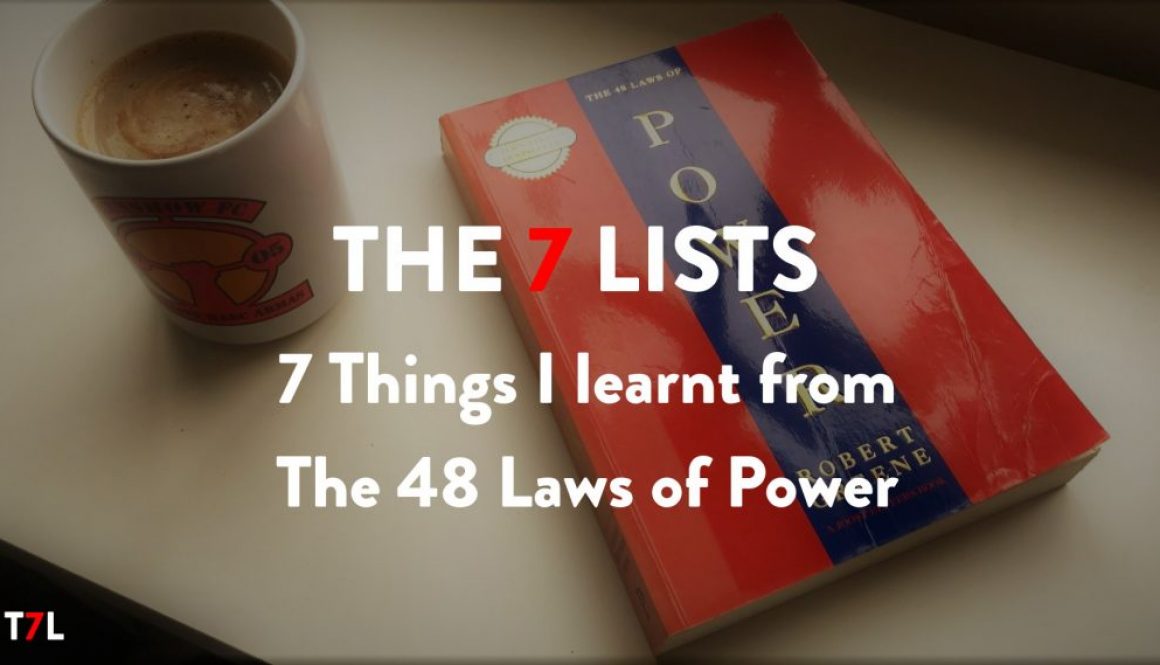7 THINGS I LEARNT FROM READING INFLUENCE
This week’s 7 List is looking at 7 things I learnt from the book Influence by Robert Cialdini. Considered by many as a masterpiece of psychological study, particularly in the fields of Marketing, Negotiation, Sales and Leadership, it is a book that continually surprises and delights on every page. Regularly cited as essential reading by the likes of Charlie Munger, James Altucher and Tim Ferriss, it breaks down the psychological principles that underpin influential methods both consciously and subconsciously.
Here are my 7 biggest takeaways from the book…
1 – THE SIX KEY PRINCIPLES OF INFLUENCE
If you take one thing away from this article, it is to memorise and instill in your memory the 6 key levers of influence. Whenever you are approaching a situation where you need to exert a degree of influence on another party, be it a sales pitch, a negotiation or any other typical situation where you need to influence someone, always consider Cialdini’s 6 principles. These principles are Consistency and Commitment, Reciprocation, Social proof, Authority, Liking, and Scarcity. By recognising and using one or any of these principles will greatly increase your probability of success in any negotiation.
2 – CONSISTENCY & COMMITMENT
People like to be consistent with the things they have previously said or done. In the words of Cialdini, “It is, quite simply, our nearly obsessive desire to be (and to appear) consistent with what we have already done.” Inconsistency is an undesirable personality trait, yet a high degree of consistency is normally associated with personal and intellectual strength. The associated bias is commitment. When we make a commitment to something, we like to remain consistent. As humans, we don’t like changing our mind.
Consistency is activated in situations by gaining small initial commitments that can be made, effectively a “foot in the door” approach.
Throughout Influence, Cialdini shares notable studies and real life examples, and in this case in one study, researchers found (rather unsurprisingly) that very few people would be willing to erect an unsightly wooden board on their front lawn to support a Drive Safely campaign in their neighbourhood. However in a similar neighbourhood close by, four times as many homeowners indicated that they would be willing to erect this unsightly billboard. Why? Because ten days previously, they had agreed to place a small postcard in the front window of their homes that signaled their support for a Drive Safely campaign. That small card was the initial commitment that led to a 400% increase in a much bigger but still consistent change. Get your foot in the door with a small request or sale, and it greatly increases the likelihood of gaining what you are really looking for.
Commitment and consistency are also highly visible when people do things like making a public statement about something like a stock price or a committing to a political statement. Once that public statement is made, the tendency is for the person who made the statement to ignore or deny dis-confirming evidence. The best antidote to this bias is arguably an outlook often described as : “Strong opinions, weakly held.” To adopt this antidote a person should do enough research so their opinions are strongly believed, but be open to new dis-confirming evidence (weakly held).
When seeking to influence using the consistency principle, the influencer needs to look for voluntary, active, and public commitments and ideally gets those commitments in writing.
If you are committed to something, no matter how small, and you accept the engagement, you’re way more likely to stick to that path further down the line. This happens even if the commitment itself gets bigger and even if, to some degree, it’s not exactly what you would normally do in the first place.
In the book, Cialdini suggests that we check in on our emotional and physical state whenever confronted with the possibility of making bad choices or at least ones that don’t resemble our real values. A sense of internal discomfort is the main cue in those scenarios, but if you take action quickly, it should be enough for stopping your approval-seeking behaviours.
3 – RECIPROCITY
Reciprocity is a “social norm of responding to a positive action with another positive action”; we tend to be nicer to those that are nice to us, and at times we even feel obliged to respond in turn when someone behaves kindly with us. If a friend invites you to their party, there’s an obligation for you to invite them to a future party you are hosting. If a colleague does you a favour, then you owe that colleague a favour. And in the context of a social obligation people are more likely to say yes to those who they owe.
One of the fields in which the reciprocity principles gets used the most is certainly the commercial one. I’ll give something to you, so you might feel that “internal discomfort” that spurs you to reciprocate and buy what I’d eventually try to sell you later on anyway.
Another variant of the reciprocity principle involves asking for a substantial favour, one that can’t usually be fulfilled, and then proceeding with a minor request represented by what we really wanted to ask in the first place. In this scenario, the second favour has a significantly higher chance of being satisfied, since it looks comparatively smaller to the original reqiuest. Furthermore, it would seem like in the second option we’re kind of looking for a compromise, making sacrifices for the greater good. This is why some stores show you the most expensive stuff first. They want you to get accustomed to higher prices, so a smaller cost requires little in the way of thought and resistance.
A good example of reciprocation in the business environment, beyond selling to customers, lies in internal business culture. When a company looks after it’s staff, when it pays them well, values them, trusts them and empowers them, it can provide a significant competitive advantage. A cultural ‘flywheel‘ develops.
“Corporate culture becomes self-reinforcing after a point.” Warren Buffett“Cultures seem to perpetuate themselves, good and bad” Shad Rowe
The company rewards the staff, the staff go the extra mile for customers, the customers reciprocate.
One eye opening study in the book discusses waiters providing a small gift, like a mint, when the bill is provided at the end of a meal. If a mint is provided, a small increase in the value of tips was noted (3%). If the gift is doubled and two mints are provided, tips don’t double. They quadruple—a 14% increase in tips. But the killer insight was the fact that if the waiter provides one mint, starts to walk away from the table, but pauses, turns back and says, “For you nice people, here’s an extra mint,” tips go through the roof. A 23% increase, influenced not by what was given, but how it was given.
So the key to using the Principle of Reciprocity is to be the first to give and to ensure that what you give is personalised and unexpected.
4 – SOCIAL PROOF
When people are uncertain, they will look to the actions and behaviours of others to determine their own. The measure through which we decide whether something is right or not is by finding out what others think is right or not.
That’s why testimonials and positive customer feedbacks have the same effect on us: we know others went through what we went or would like to go through, so it’s way easier to make a decision. And the bigger the number of people that likes an idea, the more optimal the idea itself looks. That’s why those Amazon reviews are all so important.
A memorable example used by Cialdini, is the reuse of towels in hotels. Hotels commonly leave a small card in bathrooms that attempt to persuade guests to reuse their towels. Hotels tend to do this by drawing a guest’s attention to the benefits that reuse can have on environmental protection. This leads to around 35% compliance, however it was noted that about 75% of people who check into a hotel for four nights or longer will reuse their towels at some point during their stay. So the hotel used this case of mass social consensus and added that information on the cards saying that 75% of guests reused their towels at some time during their stay. When this was done, towel reuse grew by a further 26%.
Rather than relying on our own ability to persuade others, we can point to what many others are already doing, especially many similar others.
5 – AUTHORITY
The principle of Authority sets out that people follow the lead of credible, knowledgeable experts.
Authority can be typified by symbols such as Titles (an example cited by Cialdini being Doctors, i.e. if a Doctor gives an order, nurses deactivate their critical thinking most of the time, following his lead almost as an automatic response. Clothes (for example, we obey those in uniform because we are hard-wired to believe they are authority figures without confirming their authenticity, or well-dressed people because they convey high-status and power) or Material Possessions (such as high value status symbols such as luxury cars, jewelry and cutting edge tech – they signal status, and those who possess them are often treated preferably).
From an influencer’s perspective, it’s important to signal to others what makes you a credible, knowledgeable authority before you make your influence attempt. One example involved a group of real estate agents was able to increase both the number of property appraisals and the number of subsequent contracts that they wrote by arranging for reception staff who answered customer enquiries to first mention their colleagues’ credentials and expertise. The impact of this led to a 20% rise in the number of appointments and a 15% increase in the number of signed contracts.
From the perspective of being influenced, to avoid this trap, always be wary of the authority’s legitimacy.
6 – SCARCITY
A personal favourite from the book, due to its sheer power. The principle of scarcity is simply that people want more of those things they can have less of.
This outlines why you commonly see sales terms such as “Limited Edition!”, “Only 500 in print!”, “When it’s gone, it’s gone!” (This is also known as “scarcity marketing”).
A classic example is when BA announced the end of the Concorde service, sales the very next day ramped up to unseen levels. The demand went through the roof, yet nothing had changed about the Concorde itself. It had become a scarce resource. And consequently a significantly more desirable resource.
From a psychological perspective, as humans, we may have a level of desire for certain items, and we end up desiring whatever it is that is scarce even more than we usually would. This is amplified further when we experience scarcity after abundance. An example, being of a parent that grants a privilege to his kid. Once that privilege is gone, the kid will claim it as something that he already acquired, reacting in an uncontrollable manner should the concession be neglected. Even deeper at a psychological level, beyond scarcity after abundance is that we tend to completely shut off our rationality when something, beside being scarce after the abundance phase, is craved by other human beings. If we have to compete with others to get what we want, our desire to get it goes through the roof. Social pressure and competition is what today spurs indecisive individuals to hurry up and buy stuff.
So when it comes to effectively persuading others using the Scarcity Principle, it’s not enough simply to tell people about the benefits they’ll gain if they choose your products and services. You’ll also need to point out what is unique about your proposition and what they stand to lose if they fail to consider your proposal.
7 – LIKING
People prefer to say yes to those that they like. There are three key factors in defining what makes a person likeable. We like people who are similar to us, we like people who pay us compliments, and we like people who cooperate with us towards mutual goals.
Another factor, at the shallowest level, is that good-looking people are more likely to get a preferential treatment. Studies suggest that good-looking people, just because of their appearance, are also more prone to receive further positive attributes, such as talent, charm, honesty and intelligence.
While you may not be able to do anything about your looks, for this principle, be sure to look for areas of similarity that you share with others and genuine compliments you can give before you get down to business.
So read the book – it truly is worth every penny. Influence can be bought on Amazon here.

Found this interesting or useful and looking for more of the same? Follow @the7lists on Twitter, Like us on Facebook or sign up to the newsletter below to get the latest 7 Lists goodness delivered straight to you!
SUBSCRIBE HERE FOR CURATED GOODNESS FROM THE 7 LISTS DELIVERED STRAIGHT TO YOUR INBOX


